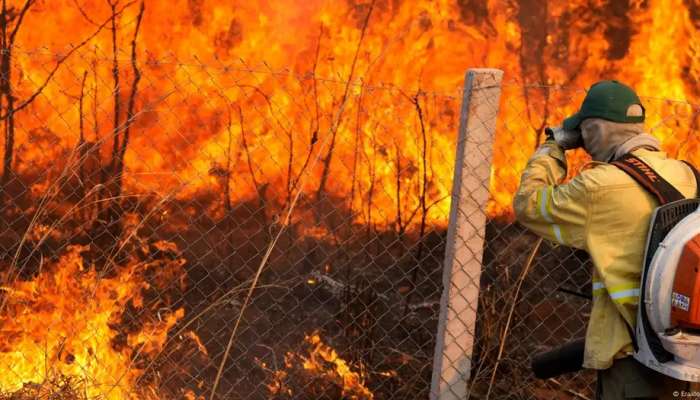
Maryland: Mariana Oliveira, a forests expert at the World Resources Institute in Brazil, didn't mince words when describing how wildfires have ravaged her country.
"Last year, Brazil experienced its most intense and widespread drought in seven decades. Combined with high temperatures, this caused the fires to spread on an unprecedented scale throughout the country," she said, speaking with reporters. "This was quite a hard year for us."
A new report from the World Resources Institute's Global Forest Watch platform and the University of Maryland in the US outlines just how hard it was — in Brazil and worldwide. Tree cover loss data show that record-breaking global temperatures contributed to a catastrophic surge in forest loss worldwide in 2024, with wildfires responsible for nearly half of the destruction.
Fires destroyed five times more primary tropical forests last year than in 2023, especially in Latin America. That made fires the leading cause of tropical primary forest loss for the first time, ahead of agriculture.
Which countries were affected by wildfires the worst?
Brazil, which is gearing up to host the COP30 climate change conference in November, saw its worst year for forests since 2016. Some 2.8 million hectares (7.0 million acres) of old-growth forest were wiped out, an area only slightly smaller than Belgium.
Two-thirds of that loss was due to fires sparked primarily by human activity. Around 80% was in theAmazon rainforest, often called the lungs of the world for its vital role in soaking up planet-heating carbon dioxide.
Forests not only mitigate the effects of climate change but also influence local temperatures and rainfall — and everything that depends on that, including agriculture and human health. Robust, biodiverse forests shelter ecosystems that, in turn, support the livelihoods of one-third of the world's population.
The hot, dry conditions and severe drought experienced in Brazil also fueled larger, more widespread blazes across South America, especially in Bolivia and Colombia. But land clearing for agriculture, especially soy and cattle ranches, along with mining and logging operations, also contributed to forest destruction, especially in Colombia.
Primary forest loss also spiked in Africa's Congo Basin, one of the world's last major carbon sinks. In one of the world's poorest areas, locals rely on the forests for food and fuel. Conflict in the Democratic Republic of Congo has also put tree cover at risk. But even here, in the neighboring Republic of Congo, fires were behind 45% of the destruction.
Why wildfires are becoming 'more intense'
"The underlying cause of a lot of this is climate change, which is ultimately fueled by human activities," said Rod Taylor, director of forests and nature conservation at World Resources Institute. But, he added, the world has entered a new amplifying phase, a "real climate change feedback loop where fires are just much more intense and much more ferocious than they've ever been."
Taylor told DW that as the forests dry out and become increasingly degraded, fires that might have once been snuffed out on their own are spreading further. "Instead of being resistant to fire, [forests are] tinder, ready to go."
The forest loss wasn't just concentrated in the tropics. Major wildfires in northern boreal forests in places like Canada and Russia added to a record disappearance of 30 million hectares worldwide in 2024, with global wildfires adding 4.1 gigatons of greenhouse gas emissions to the atmosphere.
Sarah Carter, a research associate at Global Forest Watch, pointed out that unlike in tropical forests, fires are part of the natural process in boreal forests. But, even here, "feedback loops of drier conditions and more intense fires are being seen as the climate warms."
How countries have reduced forest loss from wildfires
A few countries managed to buck the trend, however. Indonesia saw an 11% decrease in forest loss in 2024 that Carter said was due, in part, to fire prevention and response efforts and the work of the private sector and local communities.
Primary forest destruction was also down 13% in neighbouring Malaysia thanks to stricter deforestation laws and increased commitment from the corporations. Part of the success in these two countries can be attributed to local communities and the private sector banding together and using new apps and shared data to quickly and easily monitor disturbances in forests and ecosystems over vast areas — and stop them.
"The advantage of this information is that it's available in near real time, so you get these alerts almost every day, which tell you where forests are being lost," Carter told DW. This, she said, along with policy action at the government level, can help protect the forests we have left. "It's crucial to have that information."
Matt Hansen, a professor at the University of Maryland and co-director of the Global Land Analysis and Discovery Lab, said efforts to reduce forest loss were being challenged in a time when governance is weakening worldwide, particularly in the US. That made information like this, however "frightening," all the more important.
"This data should spur much more than concern," said Hansen, and instead push governments and people to act.